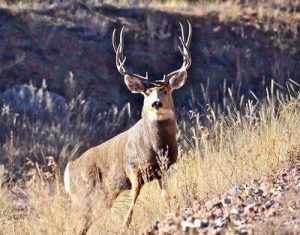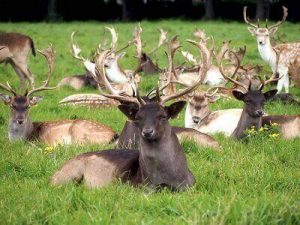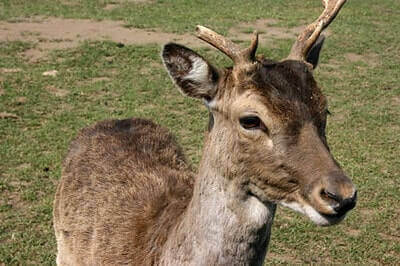Disclosure: We may earn commissions if you purchase products after clicking on a link from our site.
Do you want to learn how to tan a deer hide? Learning how to tan a deer hide is not difficult. However, it is labor intensive and takes some time. But in the end, you will have a soft and pliable deer hide that can be hung up or used as a rug to remember that first kill or challenging one. In this article, we give you the step-by-step procedure to tan a deer hide.

How To Tan A Deer Hide
- Fleshing The Hide
Whether you took the skin from a refrigerator or it is a fresh hide, the first thing you want to do is to remove all of the remaining flesh, fat, muscle, and membrane using a scraping tool. It is a good idea to put the deer hide in the refrigerator the day before you do the fleshing process. The refrigerator hardens the meat and fat which makes it easier to remove.
Place the hide on a scraping beam or other surface. You want to be very careful as you do this to avoid piercing it. Work every area of the skin including the edges. Carefully scrape all excess material from the skin. For a very good tanning job of the skin, it must be completely cleaned of flesh, fat, muscles, etc.
2. Salt The Deer Hide
After thoroughly fleshing the hide, you want to completely cover the deer hide with non-iodized salt. The salt absorbs all of the fluids out of the hide. This is called curing the hide. A quarter-to-half-inch layer of salt is a good measurement to go by. Make sure every inch of the hide is completely covered with salt. Keep it covered with salt for a day. That will give the salt the time needed to dry off all fluids.
3. Soak The Hide In Water
Pickling the hide kills any bacteria left on it. Pickling the hide prepares the hide for tanning. Add about five gallons of water to a container. Then add two quarts of non-iodized salt to the water and stir the mixture. You can then add the pickling acid.
If you don’t have a pickling acid, you can make your own pickle solution by adding equal parts of distilled white vinegar and water plus two pounds of salt per gallon of solution. Immerse the deer hide in the pickle solution for three days. Regularly stir the solution during the three days.

4. Neutralize The Hide
After three days, make a solution with four to five gallons of water and two cups of baking soda. Immerse the hide in this solution for 30 to forty minutes. This neutralizes the acid wash.
Then neutralize the skin by soaking it in a solution made from four gallons of water mixed with two cups of baking soda for up to forty minutes. Rinse in clean water and towel dry.
5. Dry The Hide
Drying the hide is a crucial step in the tanning process when preparing a deer hide for various purposes. After the hide has been thoroughly rinsed to remove any traces of tanning agents or contaminants, it is carefully stretched out flat, flesh side up, in a well-ventilated area away from direct sunlight.
This allows the hide to air dry slowly and evenly, which helps to prevent it from becoming stiff or brittle. It’s essential to avoid exposing the hide to high-heat sources, such as heaters or hair dryers, as this can cause the leather to shrink or crack. Depending on environmental conditions such as humidity levels, drying can take several days to a week or more.
Throughout the drying process, the hide should be periodically checked and gently stretched or smoothed to prevent any wrinkles or folds from forming. Once completely dry, the deer hide will be supple and ready for further processing or use in crafting projects, garments, or decorative items.
6. Apply Tanning Oil
With the skin lying flat on a surface, apply tanning oil to every part of the skin. The tanning oil prevents it from cracking or drying out. Don’t be economical with the tanning oil. Make sure the skin is well-oiled. Leave it with the tanning oil overnight.
On the next day, you want to fill a container with five gallons of water. Immerse the skin in the water to rinse off any excess oil. This will in no way hinder the tanned hide. Dry the hide with towels and lay it flat on a surface to stretch and work every inch of it. Working the hide will keep it soft as it dries.

7. Working The Hide
The hide may be stiff and may need to be worked. You can use the back of a chair or any object to break the stiff fibers of the hide to make it pliable and soft. The longer you work the hide, the softer and pliable it becomes. Work every part of the hide until it becomes soft to your liking. After you get it to the desired softness, you will have completed tanning the deer hide.
Tools For Tanning A Deer Hide
- Scraping Tool
A scraping tool is an indispensable tool in the process of tanning a deer hide. This tool, often a specialized knife or fleshing tool, is used to remove excess flesh, fat, and membrane from the flesh side of the hide. By carefully scraping the hide, the tanner can thin it to a consistent thickness, ensuring that it will tan evenly and produce high-quality leather.
The scraping process also helps to open up the pores of the hide, allowing it to absorb tanning agents more effectively. Depending on the size and type of the hide, different scraping tools may be used, ranging from hand-held knives to larger scraping tools mounted on a frame or bench. Regardless of the specific design, a sharp scraping tool is essential for achieving a smooth, uniform finish on the deer hide during the tanning process.
2. Non-iodized Salt
Non-iodized salt plays a crucial role in the tanning process of deer hide. After the initial fleshing and rinsing steps, the hide needs to be preserved to prevent it from rotting before it can be tanned. Non-iodized salt is used to cure the hide by applying a generous layer of salt onto both sides of the hide. This salt absorbs moisture from the hide, inhibiting bacterial growth and preserving the integrity of the skin.
Additionally, the salt helps to draw out any remaining moisture from the hide, preparing it for the subsequent tanning process. Non-iodized salt is preferred over iodized salt because iodine can negatively affect the tanning process and result in discoloration or other undesirable effects on the finished leather. Therefore, non-iodized salt is an essential item for anyone undertaking the tanning of a deer hide, ensuring that the hide remains in optimal condition throughout the tanning process.
3. Large Container
A large container is an essential item for tanning a deer hide, as it provides a suitable space for soaking and treating the hide during the tanning process. Typically, a container such as a plastic tub or a wooden barrel is used to hold the tanning solution and submerge the hide completely. The size of the container should accommodate the entire hide without folding or overlapping to ensure even treatment.
Additionally, the container should be large enough to allow ample room for stirring and agitating the hide during the tanning process. This facilitates proper penetration of the tanning solution and ensures uniform coverage on the hide’s surface. A large container is indispensable for effectively tanning a deer hide, providing the necessary space and functionality to achieve high-quality results in the tanning process.
4. Plastic Gloves
Plastic gloves are an indispensable item when tanning a deer hide, serving to protect the hands from direct contact with tanning chemicals and solutions. These gloves provide a barrier between the skin and potentially harmful substances, such as strong acids or alkalis used in the tanning process. By wearing plastic gloves, tanners can minimize the risk of skin irritation, chemical burns, or allergic reactions that may occur when handling tanning agents.
Additionally, plastic gloves help maintain cleanliness and hygiene throughout the tanning process by preventing the transfer of oils, dirt, or contaminants from the hands to the hide. This ensures that the tanning solution adheres uniformly to the hide’s surface without interference from external substances. Overall, plastic gloves are essential safety equipment for tanners, promoting safe and efficient handling of chemicals while tanning deer hides.
5. Protective Eyewear
Protective eyewear is an essential item when tanning a deer hide, providing safeguarding for the eyes against potential splashes or spills of tanning chemicals. These specialized glasses or goggles shield the eyes from harmful substances such as acids, alkalis, or solvents commonly used in the tanning process. By wearing protective eyewear, tanners minimize the risk of eye irritation, burns, or injuries that may result from accidental contact with tanning agents.
Additionally, protective eyewear helps maintain clear vision and visibility during the tanning process, ensuring precision and accuracy when handling chemicals and working with sharp tools. Overall, protective eyewear is a vital safety precaution for tanners, promoting safe and secure handling of tanning materials while tanning deer hides.
6. Stirring Stick
A stirring stick is a fundamental tool used during the tanning process for deer hides, facilitating thorough mixing and agitation of tanning solutions. Typically made of wood or plastic, stirring sticks are long and slender, allowing tanners to reach into containers and effectively blend the tanning agents with water or other liquids.
By stirring the solution regularly, tanners ensure uniform distribution of chemicals and promote even penetration of the tanning solution into the deer hide. This promotes consistent results and helps achieve the desired softness, flexibility, and durability in the finished leather.
Additionally, stirring sticks aid in dissolving powders or granules, preventing clumping or uneven dispersion of tanning agents. Overall, the stirring stick is an indispensable tool in the tanning process, contributing to the successful transformation of deer hides into high-quality leather products.
7. Tanning Oil
Tanning oil plays a crucial role in the process of transforming a deer hide into supple, durable leather. This specialized oil contains emollients and conditioning agents that help soften the hide, preserve its flexibility, and enhance its resistance to water and wear. During the tanning process, the deer hide is soaked in a solution containing tanning oil, allowing the oil to penetrate deeply into the fibers. This penetration helps to lubricate the collagen fibers within the hide, making them more pliable and preventing stiffness.
Additionally, tanning oil helps to seal the hide’s surface, protecting it from environmental damage and ensuring long-lasting durability. Depending on the desired finish, tanners may choose from various types of tanning oils, each offering unique properties such as waterproofing, color enhancement, or natural sheen. Overall, tanning oil is an essential component of the tanning process, contributing to the production of high-quality leather products from deer hides.
8. Towels
A towel is a versatile tool often used in the tanning process of a deer hide. It serves multiple purposes throughout the various stages of tanning, from initial cleaning to final drying. Initially, a towel can be used to blot excess moisture from the hide after rinsing or washing, helping to speed up the drying process. During the fleshing and stretching stages, a towel can provide traction and grip, allowing tanners to exert controlled pressure and remove flesh or stretch the hide evenly.
Additionally, when applying tanning solutions or oils, a towel can serve as an absorbent surface, preventing spills or drips and ensuring even distribution. Once the tanning process is complete, a towel is indispensable for gently patting the hide dry and removing any residual oils or solutions. Overall, a towel is an essential tool in the tanner’s arsenal, facilitating the efficient and effective processing of deer hides into high-quality leather products.
9. Large Paintbrush
A large paintbrush is a practical tool utilized in the tanning process of a deer hide, particularly during the application of tanning solutions or oils. Its broad bristles enable smooth and even distribution of these substances across the surface of the hide, ensuring thorough coverage and penetration. The large size of the paintbrush allows for quick application, reducing the time and effort required to treat the entire hide.
Additionally, the bristles of the brush are often soft and flexible, minimizing the risk of damaging the delicate hide during application. This makes the large paintbrush an indispensable tool for tanners seeking to achieve consistent and professional results in their tanning endeavors.
10. Tanning Solution
A tanning solution is a vital component in the process of tanning a deer hide, serving to chemically stabilize the proteins within the skin fibers, preventing decomposition and ensuring long-term preservation. These solutions typically contain tanning agents such as chromium salts, alum, or vegetable extracts like tannic acid, which react with the proteins in the hide to form a durable and flexible material.
Tanning solutions come in various formulations, including liquids, powders, or pastes, and are applied to the prepared hide using methods such as soaking, spraying, or brushing. The choice of tanning solution depends on factors such as the desired softness, color, and durability of the finished hide, as well as personal preference and environmental considerations. Regardless of the specific formulation used, a tanning solution is essential for transforming raw deer hides into durable and usable leather products.
11. Sharp Skinning Knife
A sharp skinning knife is an indispensable tool in the process of tanning a deer hide, facilitating the initial removal of the hide from the animal’s carcass with precision and efficiency. The sharpness of the blade enables clean and smooth cuts, minimizing damage to the hide and ensuring that it can be properly processed for tanning.
Skinning knives come in various designs, including fixed blades and folding knives, with different blade shapes and lengths to suit individual preferences and specific tasks. The ergonomic handle provides a comfortable grip and control during use, allowing the user to maneuver the knife with accuracy and safety. Whether it’s removing the hide in the field or preparing it for further processing in the tanning process, a sharp skinning knife is an essential tool for hunters and tanners alike.
12. Dull Fleshing Knife
Using a dull fleshing knife when tanning a deer hide can significantly impede the process and compromise the quality of the finished product. Unlike a sharp fleshing knife, which efficiently removes flesh and fat from the hide’s surface, a dull knife can tear the hide, leaving behind uneven patches and potentially damaging the grain. This can result in a hide that is more difficult to tan and may exhibit inconsistencies in texture and appearance.
Additionally, a dull knife requires more force to achieve the desired effect, increasing the risk of accidental cuts or injuries to the user. Therefore, it is essential to maintain the sharpness of the fleshing knife by regularly sharpening it using appropriate tools and techniques, ensuring optimal performance and better results in the tanning process.
13. Fleshing Beam
A fleshing beam is an essential tool used in the process of tanning a deer hide. It consists of a sturdy beam, often made of wood or metal, with a smooth and flat surface. The hide is stretched over the beam, flesh side up, to provide a stable work surface for fleshing and thinning the hide.
The smooth surface of the beam allows for easy manipulation of the hide and facilitates the removal of excess flesh, fat, and tissue from the hide’s underside. This step is crucial for preparing the hide for tanning by ensuring that it is clean, free of debris, and uniform thickness. A well-designed fleshing beam provides support and stability, allowing the tanner to work efficiently and effectively while minimizing the risk of damage to the hide.

The Bottom Line
How to tan a deer hide is not as difficult as it seems. If you deer hunt, you will need to learn how to tan the hide. It involves a series of steps to get the hide to the desired softness you want. In this article, we go through the steps to tan a deer hide.
It is our hope that after reading this article, you will have the information and confidence to take on your first tanning job. If you are interested in using ground blinds for hunting, this article on how to deer hunt in ground blinds will give you the information you need. You can also read how to tan a rabbit hide, and how to preserve game meat.
